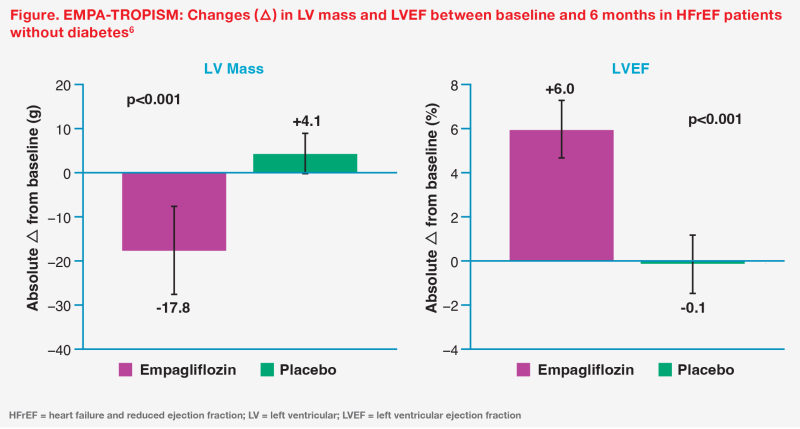Marked improvement of LVEF with an SGLT2i in a patient with nonischaemic HFrEF





History and presentation
A 45-year-old female with a sedentary lifestyle presented with lower extremity oedema in 2023. She was slightly overweight (26 kg/m2) and had no prior history of cardiac disease. Her busy lifestyle precluded regular health check-ups.
Initially, based on her family history, the patient was concerned that the oedema might indicate an underlying malignancy and consulted noncardiology specialists. A CT scan revealed a benign mass, which was surgically removed. However, her oedema persisted after the operation.
Suspecting other causes of oedema, further consultation was sought. Her blood pressure (BP) was elevated at 164/92 mm Hg. N-terminal pro-B-type natriuretic peptide (NT-proBNP) level was also elevated at 962 pg/mL. Echocardiography revealed severely reduced left ventricular ejection fraction (LVEF) of 28 percent, with an LV mass of 195 g/m². CT angiogram showed normal coronary arteries. Renal and hepatic function remained normal. (Table)

Based on these results, the patient was diagnosed with nonischaemic heart failure with reduced ejection fraction (HFrEF). Although she did not report any shortness of breath (SoB), this might have been masked by her limited physical activity. She was suspected to have had undiagnosed hypertension for a long period, which was likely the main cause of her HF.
Treatment and response
The patient was hospitalized for 1 week for postoperative recovery. During hospitalization, she was started on four pillars of guideline-directed medical therapy (GDMT) for HFrEF simultaneously, including the sodium-glucose cotransporter-2 inhibitor (SGLT2i) empagliflozin (10 mg/day), bisoprolol (5 mg/day), spironolactone (25 mg/day), and sacubitril/valsartan (200 mg/day). As all four agents have BP-lowering effects, they were initiated at low doses with caution. The patient was in good condition at discharge. The medications were gradually uptitrated to maximum tolerated doses over a 3-month period, without any symptomatic hypotension reported. (Table)
After 3 months of treatment, the patient demonstrated significant clinical improvement. Her oedema had completely resolved with no recurrence. With no SoB noted, she was encouraged to increase physical activity. Echocardiography showed a remarkable increase in LVEF to a near-normal level of 54 percent, with an LV size/mass of 153 g/m². The patient tolerated GDMT well with no adverse events reported. Her BP was well controlled at 114/67 mmHg. (Table)
The patient has been followed up every 3 months. As of June 2025, she remained clinically stable on GDMT, with stable BP and no new cardiovascular (CV) events or HF-related hospitalizations (HHF). (Table)
Discussion
HF is a major health burden affecting 1.2 percent of the population in Hong Kong.¹ Despite its prevalence, HF is often underdiagnosed as it can arise from various ischaemic and nonischaemic causes and present with diverse clinical features.2 Our patient, for example, presented with lower extremity oedema without other classical signs such as SoB, making timely diagnosis of HF more challenging. Comorbidities with overlapping symptoms are also common in HF patients, which further complicates the clinical picture and hinders accurate diagnosis.2
While internal medicine physicians frequently encounter HF and recognize its prevalence and symptoms, particularly among elderly patients, general practitioners and other specialists may have less awareness, which further contributes to missed or delayed diagnoses.3 It is important for individuals to undergo regular health check-ups, including general blood tests, starting at least in their late 30s to help identify risk factors and treat reversible conditions (eg, hypertension) early. This may help prevent progression to HF or other cardio-renal complications.4
Patients with nonischaemic HF often experience greater improvement in LVEF compared with those with ischaemic HF, as myocardial damage in ischaemic cases tends to be irreversible.5 Our patient with hypertension, but no history of coronary artery disease, demonstrated a rapid improvement in LVEF (from 28 to 54 percent) within 3 months of GDMT, highlighting how the nonischaemic HFrEF subgroup tends to benefit from treatment.
The improvement in the patient’s LVEF may be explained by empagliflozin’s potential in reversing cardiac remodelling. In the EMPA-TROPISM trial involving nondiabetic patients with HFrEF, empagliflozin reduced LV mass (-17.8 vs 4.1 g; p<0.001) and improved LVEF (+6 vs -0.1 percent; p<0.001) vs placebo by month 6, as determined by cardiac magnetic resonance. These findings indicate a beneficial effect on LV remodelling.6 (Figure)

The reverse cardiac remodelling effects of empagliflozin may be driven by improvements in ventricular loading conditions, primarily through reduction in preload due to SGLT2is’ diuretic and natriuretic effects, which may decrease congestion and potentially explain the observed reduction in LV volume in EMPA-TROPISM. Additionally, empagliflozin may decrease cardiac afterload by lowering arterial stiffness, leading to improved ventricular-arterial coupling and cardiac efficiency. Other hypotheses include SGLT2is’ anti-inflammatory or antioxidant effects, increased erythropoietin levels with improved oxygenation, as well as inhibition of the Na/H exchanger.6
In the EMPEROR-Reduced trial in HFrEF patients, empagliflozin significantly reduced the composite risk of CV death or HHF by 25 percent vs placebo (p<0.001), with consistent benefit observed regardless of diabetes status.7
Recognizing the key role of SGLT2is in HFrEF management, the American Heart Association’s 2022 guidelines provide a Class IA recommendation for their use in patients with symptomatic chronic HFrEF to reduce HHF and CV mortality, irrespective of presence or absence of type 2 diabetes.8